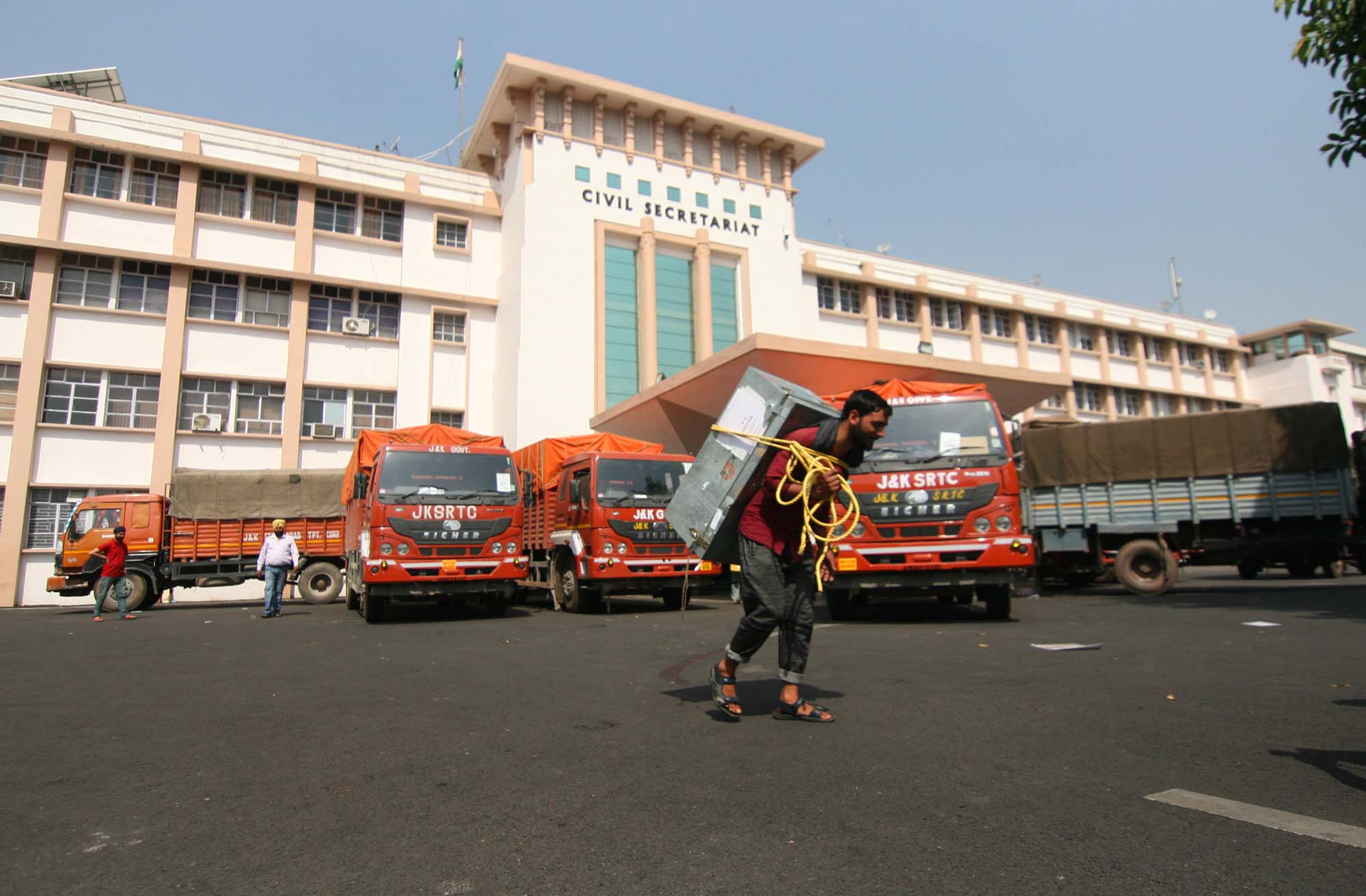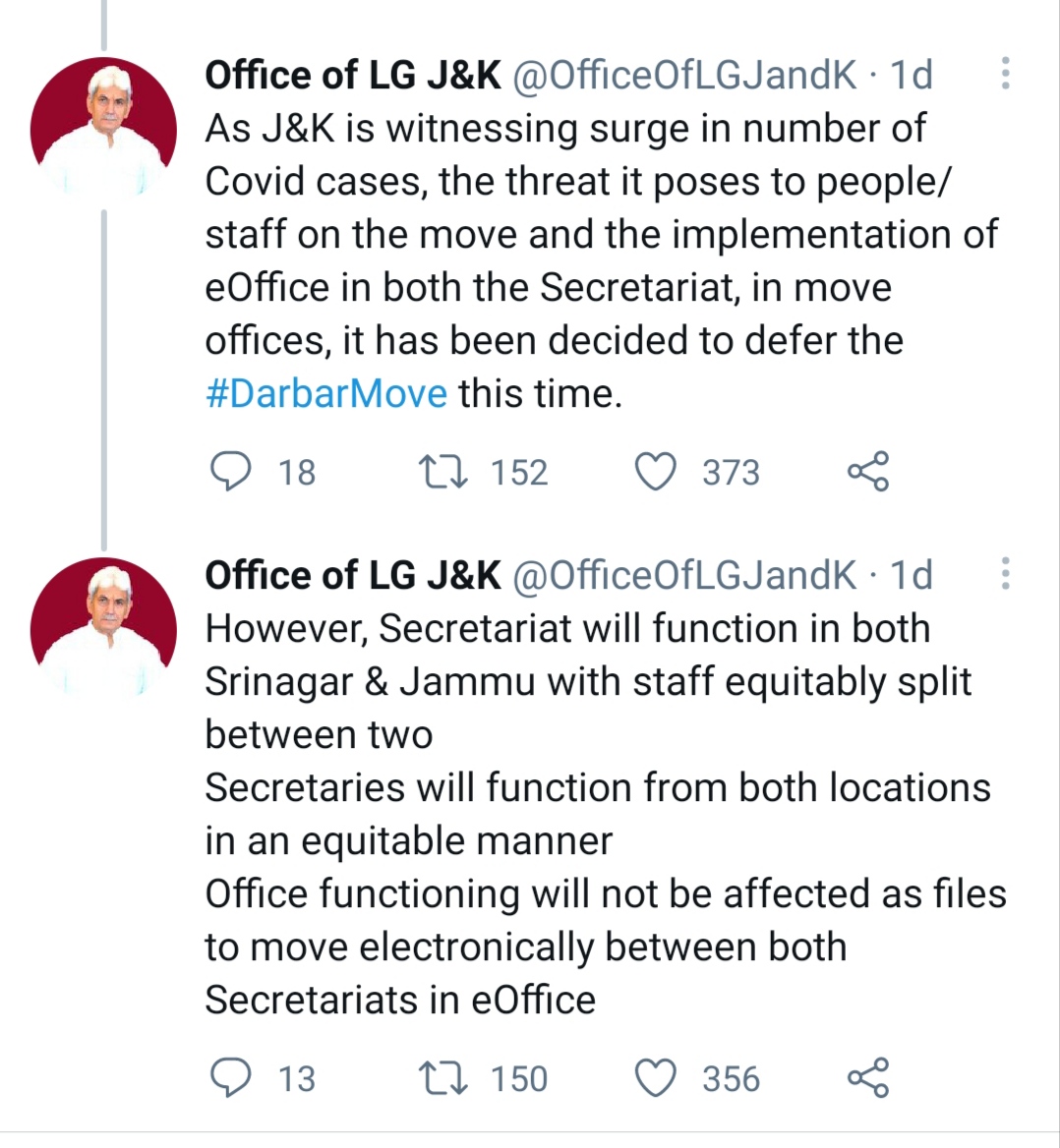Examining the History of Significance of the Darbar Move in Jammu and Kashmir
Analyzing the Jammu and Kashmir administration’s order to suspend its annual darbar move exercise this year in light of the pandemic, RAJA MUZAFFAR BHAT delves into the history of this bi-annual practice of shifting the Union Territory’s Civil Secretariat between its summer and winter capitals. Reporting from Srinagar, he attempts to explain this order’s significance for the people of Jammu and Kashmir.
NOT many people in the rest of India may be aware that the entire Civil Secretariat in Jammu and Kashmir, along with most other government offices, shifts from Srinagar to Jammu soon after the onset of winter (that is, towards the end of October) every year. These offices operate in Jammu for six months, from November to April. At the onset of summer (that is, towards the end of April), the state government offices in Jammu are shut, and shifted back to Srinagar, where they become operational from the first week of May. This bi-annual movement of the entire state government machinery is called Darbar Move (literally ‘movement of the darbar’).
The darbar move has a 150 year old history dating back to 1872, when the province of Kashmir, then-known as Riyasat-e-Kashmir, covered a vast area encompassing the Kashmir valley, the Jammu hills and plains, Poonch, Mirpur, Ladakh , Gilgit , Baltistan and Aksai Chin. Kashmir’s second Dogra ruler, Maharaja Ranbir Singh, is said to have begun the practice in that year of moving his entire durbar officially between Jammu and Srinagar. His father Maharaja Gulab Singh, too, is known to have occasionally shifted his administrative office, or darbar, to Jammu in winter and Srinagar in summer occasionally.
Genesis of the darbar move
The evolution of the darbar move can be traced back to more than 400 years ago during the rule of Mughal emperor Jahangir. After ascending the throne upon the death of his father Akbar in 1605, Jahangir visited Kashmir several times. Due to his love for mountains and valleys, the Kashmir valley became his favorite destination, and almost every year during the summers he would temporarily move to Kashmir along with his whole darbar. His beloved wife Noor Jahan would always accompany him to Kashmir.

Durbar Move: Jammu to Srinagar
Jahangir and his brother-in-law Asif Khan are said to be the architects of Kashmir’s Mughal gardens (such as Nishat Bagh, Shalimar Bagh, and Achabal Gardens, among others). Jahangir, in fact, passed away in Kashmir while on his way to Lahore from Srinagar in the fall of 1627.
Due to Jahangir’s frequent visits, Kashmir virtually became the capital of his Mughal Empire. This precedent was subsequently followed by the British and Dogra rulers.
For instance, in 1863, the Viceroy of India, John Lawrence, decided to shift the capital of the British Raj to Shimla during the summer. Shimla was also made the summer headquarters of the Indian Commander-in-Chief, then the head of the Indian Army, as well as many departments of the colonial government.
After the Dogra rule in Kashmir ended with the signing of the Instrument of Accession between Maharaja Hari Singh (the last Dogra ruler) and the then-Governor General of India, Lord Mountbatten, on October 26th 1947, Sheikh Mohammad Abdullah was elected as Kashmir’s emergency administrator. He subsequently became Prime Minister of Jammu and Kashmir (J&K) in early 1948. Sheikh Abdullah didn’t stop the traditional darbar move, which continued through the years till last year, when only some officers and offices were shifted to Srinagar in April amid the COVID-19 pandemic.
By the end of October last year, when the civil secretariat offices that had shifted to Kashmir in April were directed to return to Jammu, it was presumed to be the normal movement of offices. However, since April 15, when the Lieutenant Governor’s office officially announced the deferment of the darbar move from Jammu to the summer capital of Srinagar, several stakeholders in Kashmir have questioned this move.
Deferment of Darbar Move
The Union Territory (UT) administration has claimed that due to the sudden upsurge in COVID-19, the bi-annual darbar move has been stalled. The UT government has declared that many offices won’t be shifted from Jammu to Srinagar for the summer session until further notice, but residents in the Kashmir Valley, who are yet to fully come to terms with the sudden undemocratic abrogation of Article 370 of the Indian Constitution in August 2019, see this decision differently.

Civil Secretariat, Jammu
Kashmiris apprehend that that the Union Government is planning to turn Jammu into a separate state, and continue with the Kashmir valley as a UT.
Fayaz Ahmad, a Srinagar-based businessman, says: “Why was the darbar move undertaken last year in October, and most offices, particularly the Civil Secretariat closed in Srinagar and opened in Jammu in the first week of November? During that time also, COVID-19 was at its peak. Such acts create confusion in the Kashmiri society, which then suspects that either the Government of India is planning to designate Jammu the capital city of J&K UT, or that Jammu will be turned into a separate state and Kashmir will continue to remain an Union Territory.“
Also read: Tracking the first year of ‘Naya Kashmir’
Last year, as part of bi-annual Darbar move, the Civil Secretariat, along with other offices, were closed in Srinagar on October 30, and the same reopened in the winter capital Jammu on November 9th. This was pursuant to an order issued by the General Administration Department (GAD) last year, which stated:
“All the departments shall ensure that records are packed in boxes after working hours on last working day in Srinagar. All Departments have been asked to send their advance parties on 23 October 2020 (Friday) consisting of one Gazetted Officer and four to five Non-Gazetted Employees who will receive the records at Jammu. The departments shall ensure that boxes are properly locked and their keys reach the advance parties at Jammu well in time. The S.S.P. Security, Civil Secretariat will furnish a list of defaulting departments in this regard to the GAD”.
Darbar Move and COVID-19?
The office of the Lt. Governor of the UT of J&K, while issuing an official statement on its Twitter handle on the deferring of darbar move, said that in view of sharply rising cases of COVID-19 in J&K, the government has, to ensure the safety of its employees, decided to defer the durbar move because of COVID; consequently, the Secretariat will function in both Srinagar and Jammu, and office functioning shall not be effected because of eOffice.
Another tweet from the office said:
“As J&K is witnessing surge in number of Covid cases, the threat it poses to people/staff on the move and the implementation of eOffice in both the Secretariat, in move offices, it has been decided to defer the #DarbarMove this time.”

Also read: BJP leader and BHU alumnus Manoj Sinha appointed as new lieutenant governor of Jammu and Kashmir
From the order of the LG, it is clear that Government has stalled the biannual darbar move to ostensibly ensure the safety of employees travelling from Jammu to Srinagar so that they don’t get infected with COVID-19. It is pertinent to note here that all the employees don’t travel together in big buses as they used to do in the past, when private transport facility was not available. Most of them, for the last several years, have either been hiring cabs or coming in their own private vehicles as the government provides each such employee a travelling allowance of Rs. 25,000.
Huge Move
There are about ten thousand employees of the J&K government who would move between Srinagar and Jammu, and vice-versa, every six months with the darbar. They include Ministers, High Court Judges, IAS and IPS officers, middle rung officers, clerical staff and class IV employees (office attendants, peons etc.), among others. The Heads of Departments (HoDs) of some government departments and Public Sector Undertakings (PSUs) under the J&K government, the Directors General (DGs) of the J&K Police, Accounts & Treasury, Prisons and Fire and Emergency Services, the Director of the Anti-Corruption Bureau, and the Managing Director (MD) of the J&K Bank and the Power Development Corporation, are also among those who move with their offices.
A significant number of officers would travel by flight from Jammu to Srinagar and vice versa; they would have been more vulnerable to getting infected with COVID-19 than those travelling in cabs or private cars. Even Class IV employees and other lower rung officials who travel in buses would have been safer than those travelling by air since these buses are almost empty, carrying only 10 to 12 officials each, which fulfills the physical distancing requirement under COVID-19 protocol. Mandating all moving officers to travel in compliance with physical distancing norms in small groups would not have been a tall task.
Also read: Life After Art. 370: How J&K Government Insults Covid Warriors
One is unable, then, to understand how the COVID infection is related to the darbar move? The only legitimate rationale to stop the exercise is that a lot of taxpayers’ money gets wasted in this expensive practice, which drains the state exchequer of crores of rupees every six months.
PIL against Darbar Move
A division bench of the J&K High Court, comprising of the then-Chief Justice Gita Mittal and Justice Rajnesh Oswal, while pronouncing its judgment in response to a public interest litigation (PIL) filed by one Azra Ismail in 2020, said that the darbar move resulted in the “wastage of tremendous amount of time, efforts and energy on an inefficient and unnecessary activity.”

Durbar Move: Jammu to Srinagar
It explained that when the practice had begun 150 years ago, it involved only a few officers, and the official record was carried in a few tongas. However, now it involved the shifting of nearly 151 government departments and over 10,000 personnel, along with thousands of official documents and equipment, loaded in over 150 trucks and transported for 300 km between Jammu and Srinagar and vice versa.
The High Court began with questioning whether the government can afford the practice of darbar move at an annual expenditure of at least Rs. 200 crore.
The court did not issue any direction to the UT government, taking note of the limitations on its jurisdiction.
“We defer this task to the best wisdom of those on whom the Constitution of India bestows this solemn duty keeping in view, the interest of the Union Territory of Jammu and Kashmir, the larger interest of its people and the mandate of the Constitution of India,” the High Court had observed.
As per official information furnished in the judgment in 2019, Rs. 1,436.81 lakhs was spent on travel allowance of UT government employees, Rs. 45.41 lakhs on the loading and unloading of goods and office files/records, Rs. 116.55 lakhs on carriage, and more than Rs. 37 lakhs on other expenses in the darbar move that year.
Attempt to abolish made by Farooq Abdullah Government in 1980s
In the late 1980s, when Dr. Farooq Abdullah was the Chief Minister of the then-state of J&K, his government had decided to bifurcate the civil secretariat and other offices permanently in order to keep some offices in Srinagar and some in Jammu, but people of Jammu agitated over the decision. A complete bandh was observed in Jammu for 45 days. Ultimately, Dr. Abdullah’s government had to withdraw its decision.
The darbar move certainly evokes a variety of often contrasting sentiments among different sections of the public of J&K. Its significance for the local citizens. Points out Farooq Kuthoo, President of the Travel Agents Association of Kashmir: “Darbar move is not only the movement of offices or government records; people have an emotional attachment with this age-old tradition. As an organization associated with tourism, we quite often have to meet senior officers and ministers in various departments of the civil secretariat. These meetings can’t always be held in virtual mode. If some officers are asked to stay in Jammu during the summer, which is a tourist season, it will create chaos and confusion. Dozens of hotels rooms and guest houses have already been booked by the Government for the moving employees; will these six-month long bookings be cancelled by government now? It will have a huge economic impact”.
The article was originally published in The Leaflet.
(Raja Muzaffar Bhat is a Srinagar-based activist, columnist, and independent researcher. He is an Acumen India fellow. The views expressed are personal.)
Get the latest reports & analysis with people's perspective on Protests, movements & deep analytical videos, discussions of the current affairs in your Telegram app. Subscribe to NewsClick's Telegram channel & get Real-Time updates on stories, as they get published on our website.
























